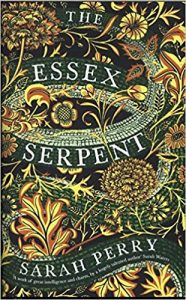This is a very popular and highly-acclaimed novel, which I have really struggled to review. Set in the Victorian era, Cora Seaborne is a woman of means freed from her abusive marriage by her husband’s death. She embraces her freedom by pursuing the science of fossil-hunting, marching through the countryside in men’s boots and coats, searching for the Essex serpent, hoping to uncover its connection to the beasts or dinosaurs of Mary Anning.
The Essex Serpent is a rich novel, with many characters, all of whom are mostly concerned with friendship. Not the friendship in which acquaintances engage in lively small talk, but the kind of friendship full of intellectual and emotional challenge. The Essex serpent becomes a symbol of all the complex dichotomies such friendships enforce: myth or religion against science; intellect against desire; propriety against equality and so on and so on.
This ability to present us with images whose many facets have been buffed to perfection is one of Sarah Perry’s skills, and one of the things that draws a reader into the novel. Most of the characters have objects, treasures, that inspire them. The brilliant surgeon, Dr. Garrett, who is in love with Cora, created an exquisitely cut portion of the lining of the human stomach no larger than a thumb, set between two pieces of glass and made to look like a tiny fan. Cora has her fossils. Martha, Cora’s son’s nanny, has her housing reforms. Francis, Cora’s son, collects all sorts of treasures in lieu of an easy interaction with the world. Mrs Ransome, the Reverend of Aldwinter’s wife, starts to collect all things blue, an obsession that grows alongside her tuberculosis. And so on, and so on…
This is where I admire and feel frustrated by the novel. I don’t believe life can be easily divided into opposing and yet conflating dichotomies and nor do I share a desire to privilege collections of treasures above a more muddy understanding and adventure into the world.
People are going to disagree with me here. They will say the novel explores liberal values, a modern attitude to sex, women and autistic spectrum disorders. They will say it gets to the heart of Victorian uncertainties about how science fits with the Church and with the established social hierarchy. But, I believe the novel is happier contemplating shiny objects than watching Cora do science. The scene where Cora meets the Reverend Ransome for the first time, unbeknown to them both, and helps him save a lamb caught in the bog, is far more successful than the scene where (look away if you don’t want spoilers) they allow their bodies to try and meet in the way their minds have. Ultimately there is a primness to the novel, a use of Victorian sensibility to provide a safe haven in which the meeting of minds should be free of the body, that goes against all the characters’ conversations about reform in the church and in society. It is a beautiful book that confirms our desire to stay firmly inside the ridiculous notion of Cartesian Dualism.
I opened the book expecting all kinds of things, and I was given moments in which I was entirely spellbound – the saving of the sheep, the watching of the ghostly ship across the Blackwater – but I felt ultimately disappointed by the distance between mind and body, world and human. I wanted to move out of the romantic adolescence of our understanding of ourselves – intense as it is – and move into something more radical that says our mind is in our bodies, our memories imprinted in our organs, our experience and thought always limited by the confines of what we are able to perceive. Where would the book go then? Why are we content to focus on the romance of Cora and her Reverend and not Martha? Why do we need to return to the Victorian era if we aren’t going to use it to challenge the present?
I really admire The Essex Serpent, but I’m also frustrated by it. Feel free to comment, argue, set me right.
Next I’ll be reviewing Reservoir 13 by Jon McGregor. A book that will definitely divide its audience.
